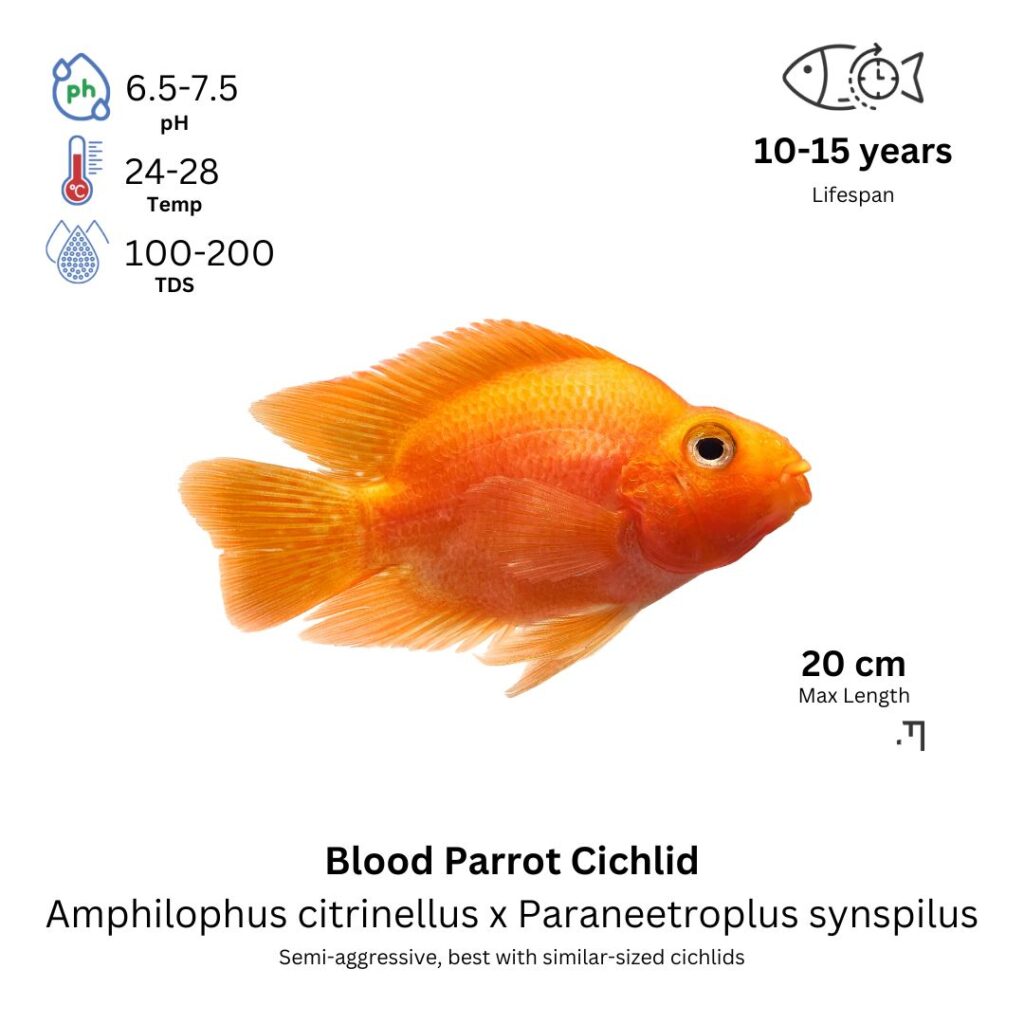Blood Parrot Cichlid
Paraneetroplus synspilus

Description
The Blood Parrot Cichlid is a hybrid fish, typically a cross between a midas cichlid (Amphilophus citrinellus) and a redhead cichlid (Paraneetroplus synspilus), though some believe it may involve other cichlid species. These fish are known for their vibrant orange or reddish coloration, with their bodies being somewhat rounded and laterally compressed. The coloration can vary from bright orange to deep red, depending on the individual, but they are almost always very colorful, making them stand out in any aquarium.
Habitat Origin
Although the Blood Parrot Cichlid is a hybrid and not a naturally occurring species in the wild, its parent species come from Central America. The Midas Cichlid and Redhead Cichlid are both found in slow-moving rivers and lakes in countries like Mexico and Honduras. In their natural habitats, these cichlids live in warm, slightly acidic to neutral waters with plenty of submerged rocks and plants, providing natural shelters and hiding spots.
Aquarium
Ideal Number in Aquarium: Best kept singly or in pairs. These fish are territorial, so adequate space is essential.
Favorite Food

Blood Parrot Cichlids are omnivores and have a wide-ranging diet. They can be fed high-quality cichlid pellets, live or frozen foods like brine shrimp, daphnia, bloodworms, and earthworms. They also enjoy plant matter, so supplementing their diet with blanched vegetables such as zucchini, spinach, and lettuce is beneficial. Providing a balanced diet will help them maintain vibrant colors and good health.
Behavior:
The Blood Parrot Cichlid is generally peaceful but can be territorial, especially when it comes to defending food or breeding areas. They are active swimmers and often spend their time exploring the tank. Despite their slightly deformed mouths, they are capable feeders and will actively search for food. They are also known for their unique, “friendly” interactions with tankmates, making them a fun fish to keep in community tanks. They may become more aggressive when breeding, and they prefer having plenty of space and hiding spots in the tank to reduce stress.
Special Care:
Blood Parrot Cichlids require stable water conditions with good filtration, as they can be sensitive to poor water quality. They are prone to certain health issues, including mouth deformities that may affect feeding, so it’s important to monitor their diet and overall health carefully. Since they are hybrid fish, there is a debate about their ethical breeding practices, but they remain popular in the aquarium trade due to their vibrant colors and interesting personalities.
Compatibility with Other Fish:
Blood Parrot Cichlids are generally peaceful with other similarly sized fish, making them suitable for community tanks with other non-aggressive species. They can live with larger, peaceful cichlids, but they should not be kept with very small fish that might be seen as prey. Avoid housing them with aggressive fish, as they can become stressed or territorial. It’s important to note that while they are peaceful, they can exhibit territorial behavior during breeding or when food is scarce.
Breeding Tank Setup
A separate breeding tank is highly recommended for Blood Parrot Cichlids due to their size and territorial behavior during spawning. A 100–150 liter (25–40 gallon) tank provides ample room for swimming and territory establishment. Maintain a pH between 7.0–8.0, a temperature of 26–30°C, and moderate hardness (6–15 dGH). Use a canister or internal filter for effective filtration, but avoid strong currents—sponge filters are excellent for gentle flow and fry safety. Use fine gravel or sand as substrate, and add flat rocks, ceramic caves, or breeding tubes as spawning sites. Moderate lighting (10–12 hours per day) with some shaded or hidden areas supports a stress-free environment.
Selecting Breeders & Conditioning
To condition the breeding pair, provide a high-quality, protein-rich diet including live or frozen brine shrimp, bloodworms, and daphnia, alongside premium cichlid pellets or flakes. This helps ensure healthy egg development and active mating behavior. Perform a partial water change (20–30%) before breeding and consider raising the temperature to 28°C (82°F) to encourage spawning. Stable, clean water is essential to promote reproductive behavior in this hybrid species.
Spawning Process
Once conditioned, spawning usually occurs on flat or cave surfaces. The female lays 200–500 yellowish eggs, which the male fertilizes externally. Blood Parrot Cichlids may spawn multiple times annually if well cared for. After egg-laying, do not separate the parents—they often share parental duties, with the male guarding the area and the female fanning the eggs for oxygenation. However, if other fish are present, consider isolating the pair to protect the eggs and future fry.
Fry Care & Feeding
The eggs hatch within 3–4 days, depending on temperature. Once the fry absorb their yolk sacs (typically by day four), begin feeding infusoria or liquid fry food. As they grow, introduce newly hatched brine shrimp or finely crushed flakes. Maintain excellent water quality by doing small water changes (10–15%) every 2–3 days, and use a sponge or gentle filter to avoid disturbing the fry. Keep the temperature consistent between 26–30°C, and avoid strong water currents.
Breeding Maturity, Sexing & Stress Prevention
Blood Parrot Cichlids reach sexual maturity between 1–2 years, though best breeding results occur once they are fully developed and in optimal health. Males are smaller and more vibrantly colored, especially during breeding, while females are larger, rounder, and less colorful. To reduce stress, avoid overcrowding, maintain stable water conditions, and remove aggressive tankmates. A calm, controlled breeding environment enhances the success rate and promotes healthy fry development.
